Abstract
Tick larvae (Boophilus microplus) were extracted, fractionated by gel filtration and ion-exchange chromatography, and the fractions assayed by enzyme-linked immunosorbent assay (ELISA) against sera from cattle immunized and protected by antigens from the mid-gut of adult ticks. Unfractionated, whole larval extracts and selected reactive components were used to vaccinate cattle; they decreased the number of ticks dropped after challenge, but the effect of treatment was not significant. Antigens purified from crude larval extracts by affinity chromatography, using immunoglobulin ligands from an immune steer vaccinated with tick mid-gut antigens, also failed to protect cattle. However, tick extracts from both larval and adult ticks, which were first separated into membrane-associated and soluble fractions and then purified by exposure to the affinity ligands, protected cattle greater than 80% against subsequent challenge with ticks.
Full text
PDF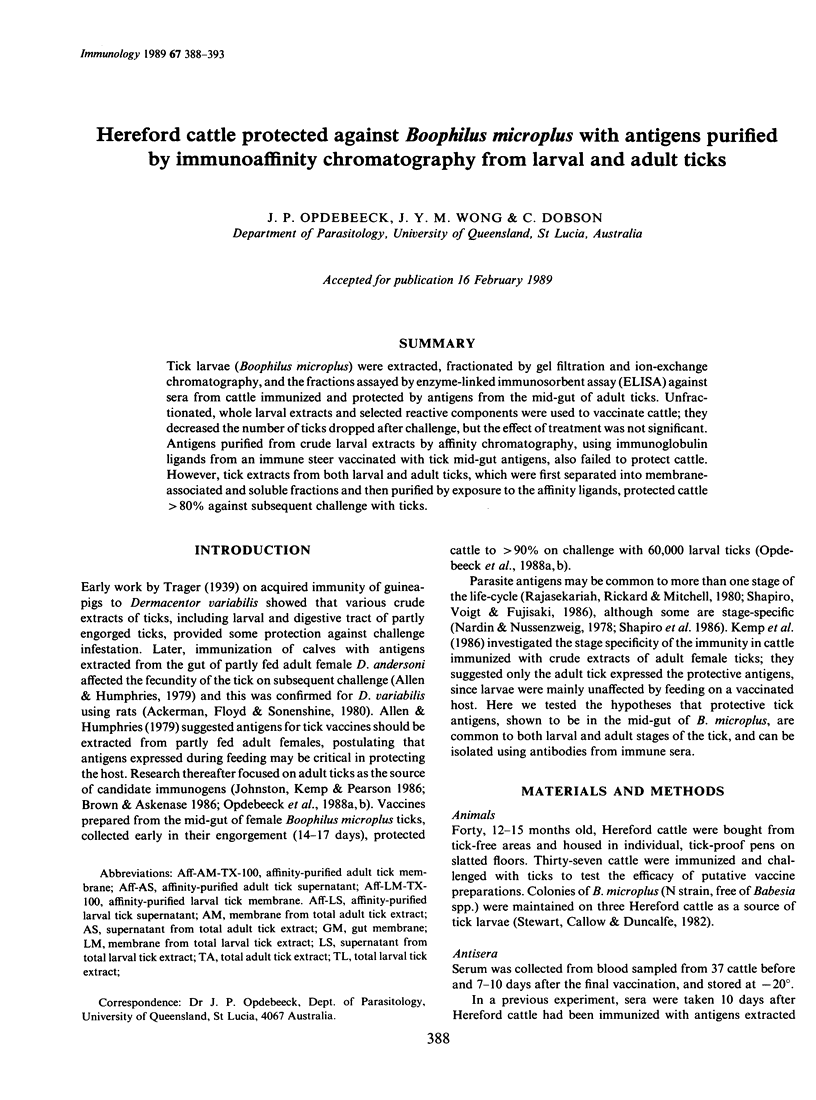
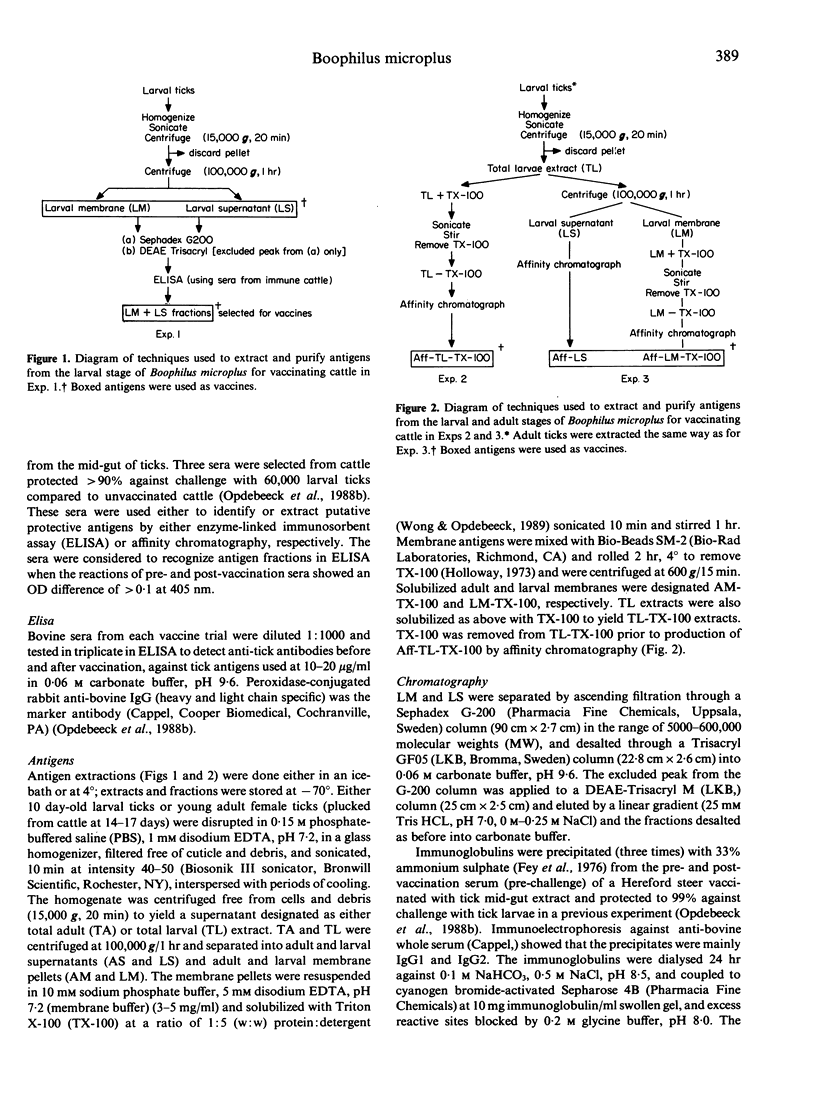
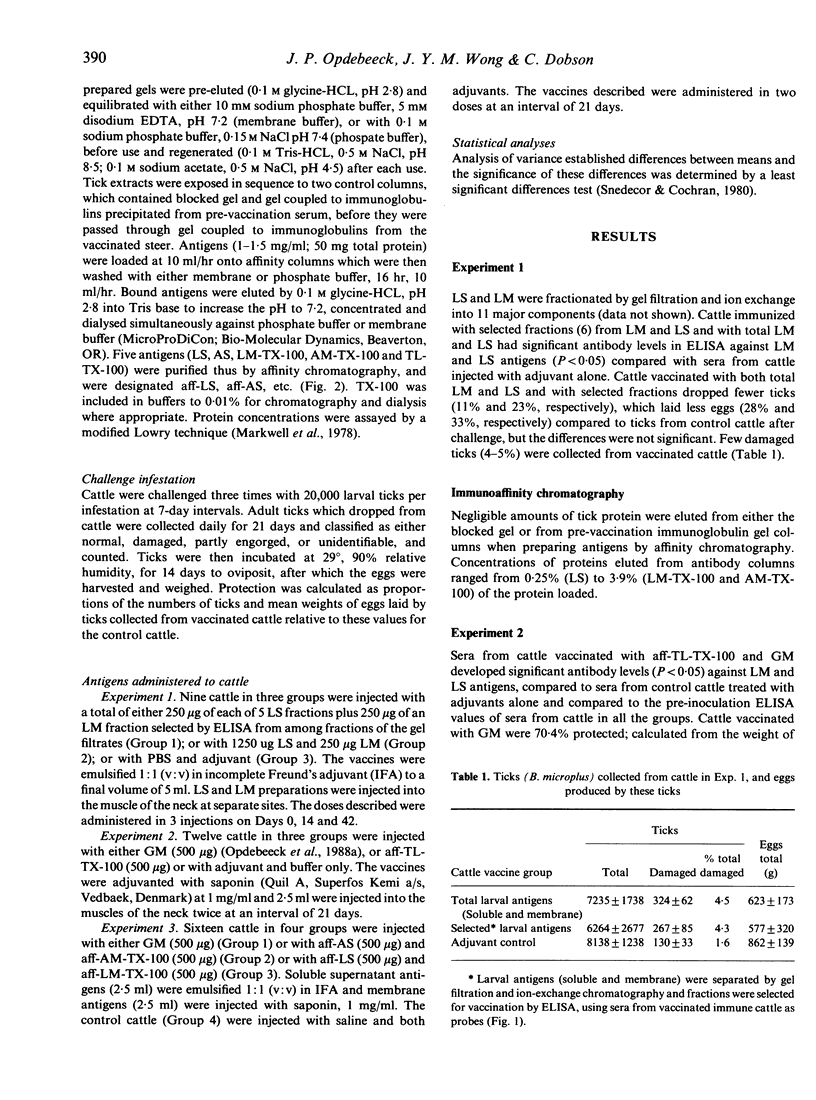
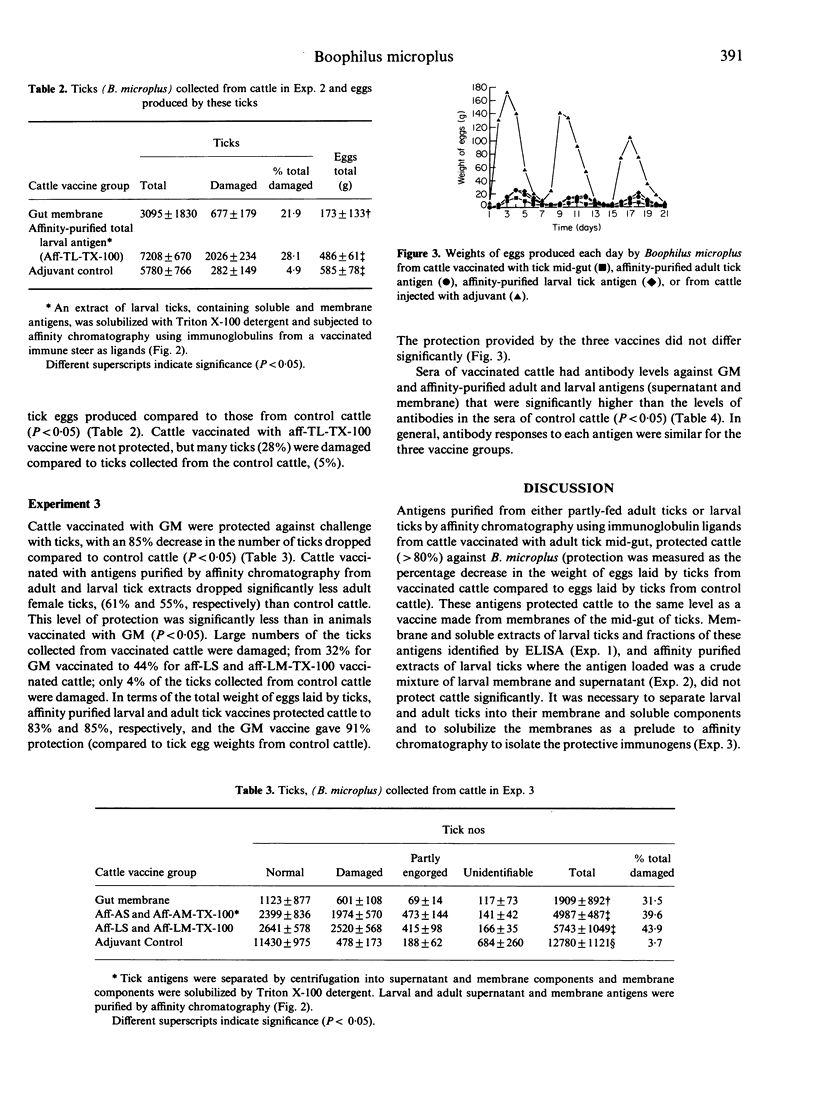
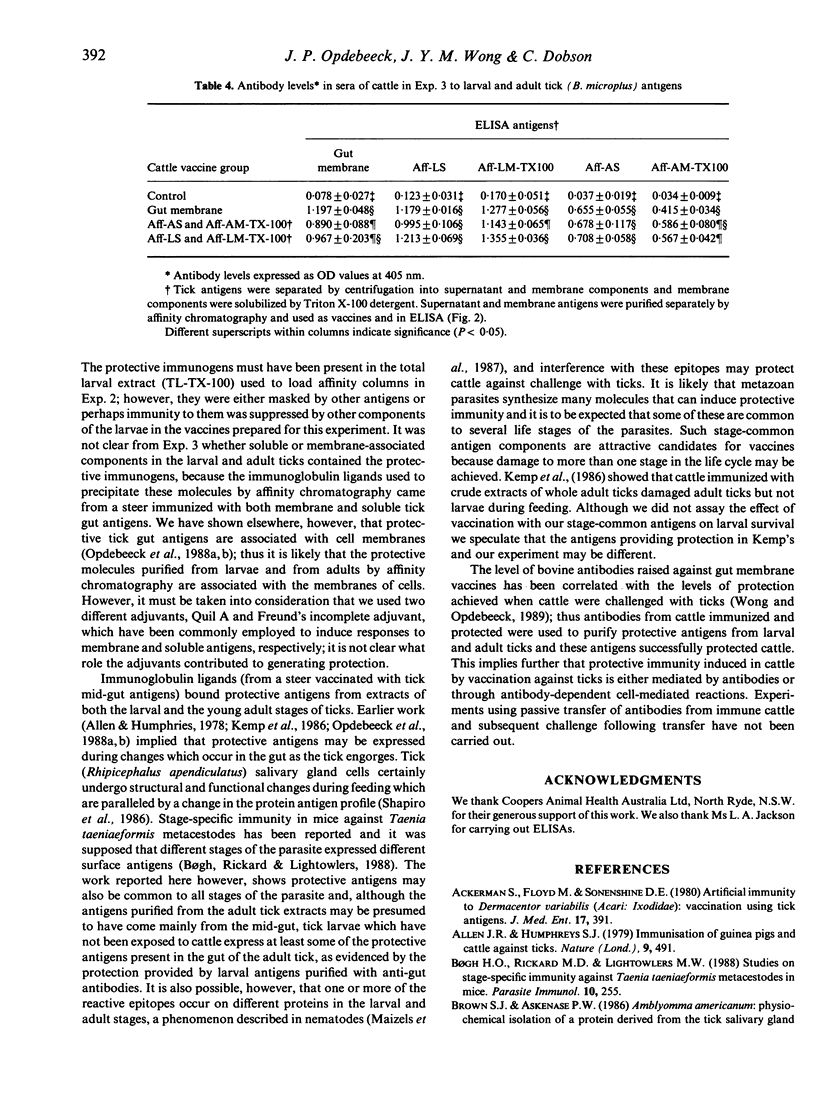
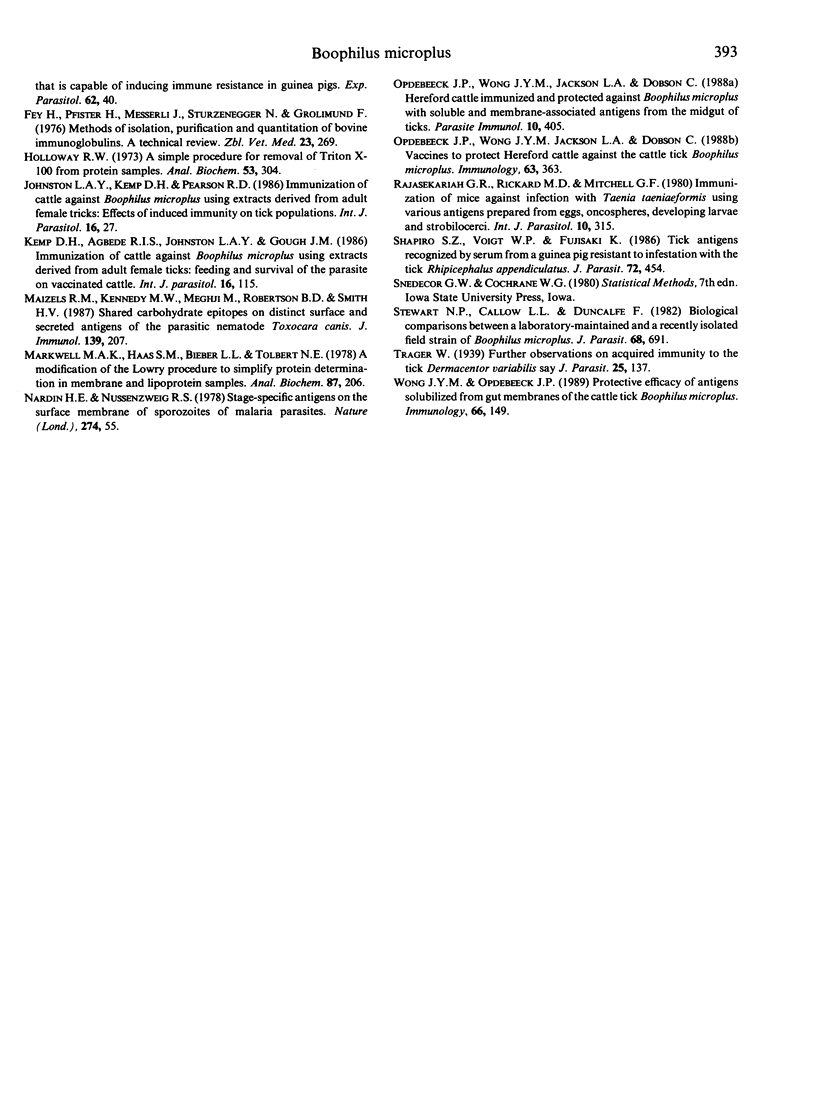
Selected References
These references are in PubMed. This may not be the complete list of references from this article.
- Ackerman S., Floyd M., Sonenshine D. E. Artificial immunity to dermacentor variabilis (Acari: Ixodidae): vaccination using tick antigens. J Med Entomol. 1980 Sep 30;17(5):391–397. doi: 10.1093/jmedent/17.5.391. [DOI] [PubMed] [Google Scholar]
- Allen J. R., Humphreys S. J. Immunisation of guinea pigs and cattle against ticks. Nature. 1979 Aug 9;280(5722):491–493. doi: 10.1038/280491a0. [DOI] [PubMed] [Google Scholar]
- Brown S. J., Askenase P. W. Amblyomma americanum: physiochemical isolation of a protein derived from the tick salivary gland that is capable of inducing immune resistance in guinea pigs. Exp Parasitol. 1986 Aug;62(1):40–50. doi: 10.1016/0014-4894(86)90006-8. [DOI] [PubMed] [Google Scholar]
- Bøgh H. O., Rickard M. D., Lightowlers M. W. Studies on stage-specific immunity against Taenia taeniaeformis metacestodes in mice. Parasite Immunol. 1988 May;10(3):255–264. doi: 10.1111/j.1365-3024.1988.tb00219.x. [DOI] [PubMed] [Google Scholar]
- Fey H., Pfister H., Messerli J., Sturzenegger N., Grolimund F. Methods of isolation, purification and quantitation of bovine immunoglobulins: a technical review. Zentralbl Veterinarmed B. 1976 May;23(4):269–300. doi: 10.1111/j.1439-0450.1976.tb00682.x. [DOI] [PubMed] [Google Scholar]
- Holloway P. W. A simple procedure for removal of Triton X-100 from protein samples. Anal Biochem. 1973 May;53(1):304–308. doi: 10.1016/0003-2697(73)90436-3. [DOI] [PubMed] [Google Scholar]
- Johnston L. A., Kemp D. H., Pearson R. D. Immunization of cattle against Boophilus microplus using extracts derived from adult female ticks: effects of induced immunity on tick populations. Int J Parasitol. 1986 Feb;16(1):27–34. doi: 10.1016/0020-7519(86)90061-5. [DOI] [PubMed] [Google Scholar]
- Kemp D. H., Agbede R. I., Johnston L. A., Gough J. M. Immunization of cattle against Boophilus microplus using extracts derived from adult female ticks: feeding and survival of the parasite on vaccinated cattle. Int J Parasitol. 1986 Apr;16(2):115–120. doi: 10.1016/0020-7519(86)90096-2. [DOI] [PubMed] [Google Scholar]
- Maizels R. M., Kennedy M. W., Meghji M., Robertson B. D., Smith H. V. Shared carbohydrate epitopes on distinct surface and secreted antigens of the parasitic nematode Toxocara canis. J Immunol. 1987 Jul 1;139(1):207–214. [PubMed] [Google Scholar]
- Markwell M. A., Haas S. M., Bieber L. L., Tolbert N. E. A modification of the Lowry procedure to simplify protein determination in membrane and lipoprotein samples. Anal Biochem. 1978 Jun 15;87(1):206–210. doi: 10.1016/0003-2697(78)90586-9. [DOI] [PubMed] [Google Scholar]
- Opdebeeck J. P., Wong J. Y., Jackson L. A., Dobson C. Hereford cattle immunized and protected against Boophilus microplus with soluble and membrane-associated antigens from the midgut of ticks. Parasite Immunol. 1988 Jul;10(4):405–410. doi: 10.1111/j.1365-3024.1988.tb00230.x. [DOI] [PubMed] [Google Scholar]
- Opdebeeck J. P., Wong J. Y., Jackson L. A., Dobson C. Vaccines to protect Hereford cattle against the cattle tick, Boophilus microplus. Immunology. 1988 Mar;63(3):363–367. [PMC free article] [PubMed] [Google Scholar]
- Rajasekariah G. R., Rickard M. D., Mitchell G. F. Immunization of mice against infection with Taenia taeniaeformis using various antigens prepared from eggs, oncospheres, developing larvae and strobilocerci. Int J Parasitol. 1980 Aug;10(4):315–324. doi: 10.1016/0020-7519(80)90013-2. [DOI] [PubMed] [Google Scholar]
- Shapiro S. Z., Voigt W. P., Fujisaki K. Tick antigens recognized by serum from a guinea pig resistant to infestation with the tick Rhipicephalus appendiculatus. J Parasitol. 1986 Jun;72(3):454–463. [PubMed] [Google Scholar]
- Stewart N. P., Callow L. L., Duncalfe F. Biological comparisons between a laboratory-maintained and a recently isolated field strain of Boophilus microplus. J Parasitol. 1982 Aug;68(4):691–694. [PubMed] [Google Scholar]
- Wong J. Y., Opdebeeck J. P. Protective efficacy of antigens solubilized from gut membranes of the cattle tick, Boophilus microplus. Immunology. 1989 Jan;66(1):149–155. [PMC free article] [PubMed] [Google Scholar]


